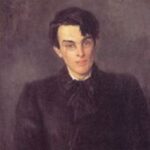Although no other story is more widely known than the life of Jesus, no other story from any other religion has caused more debate to arise. In The Magi, Yeats focuses on the birth and death of Jesus’ life. Written in 1914, The Magi follows the journey of the “unsatisfied ones” and their unrequited search for meaning in the “uncontrollable mystery on the bestial floor.” Yeats uses the wise men (the “unsatisfied ones”) to allude to his belief that mankind has yet to discover meaning and fulfillment in Jesus’ time on earth.
The religious imagery in The Magi helps convey the themes of desire and dissatisfaction. According to the Bible, the magi (who were known as wise men from the East) followed a bright star that led them to the birth of Jesus. They worshipped him and gave him gifts of gold, myrrh and incense. In Yeats’ The Magi, the wise men are the “unsatisfied ones.” Not only do they witness the birth of Jesus, but his death as well at Calvary, which is the hill near Jerusalem where Jesus was crucified. Although they see these miraculous events, they are left unfulfilled, “being by Calvary’s turbulence unsatisfied.” The “uncontrollable mystery on the bestial floor” could be pertinent to the birth of Jesus on the stable floor that he was supposedly born upon. But knowing the ideology of Yeats and his belief in the Second Coming causes us to infer another meaning. The Second Coming, which he wrote in 1920, is based on the theory that the birth of the Anti-Christ will come at the start of the millenium. So the “bestial floor” most likely refers to its literal meaning, which is “belonging to beasts”, and the “uncontrollable mystery” is the birth of the Beast, the Anti-Christ. This foreshadows the conclusion of The Second Coming: “And what rough beast, its hour come round at last/Slouches towards Bethlehem to be born?” As the wise men in The Magi are waiting with their “eyes still fixed” upon the bright star, they won’t be satisfied until they are led to the “uncontrollable mystery on the bestial floor.”
Although The Magi is a short poem, it is riddled with plenty of diction and syntax to amplify its meaning. The magi seem almost otherworldly as they “appear and disappear in the blue depth of the sky” and are constantly in the poet’s head (“Now as at all times I can see in the mind’s eye). Yeats’ descriptions of the magi drill the words into the reader’s head. For example, he describes the wise men as “unsatisfied” twice in lines 2 and 7. He uses a series of s-sounding words such as: stones, stiff, still fixed, helms of silver hovering side by side, and unsatisfied. These are the characteristics of the magi, who are unchanging with “stiff, painted clothes.” This could pertain to the depiction of the wise men in religious art, who are usually shown wearing fine, rich clothing. They are weary and “pale” with “ancient faces” that resemble “rain-beaten stones” and are forever waiting, “all their eyes still fixed, hoping to find once more” the events that will satisfy their quest for meaning.
Yeats’ repeats the word “all” when he describes the magi, which may allude to humankind as a whole (“With all their ancient faces”, “And all their helms of silver”, “And all their eyes still fixed”). Perhaps Yeats is pointing out the fact that despite our progression into each new century or era, mankind is still baffled by religion, which has yet to be resolved into one solution for everyone. Christ’s coming to earth has left us even more dissatisfied and more fervent in our search for meaning. We won’t be fulfilled until “the uncontrollable mystery” arrives, or the emergence of the Anti-Christ, which according to the Bible, is when the world will begin to end.
Yeats wrote The Magi in conjunction with The Dolls: “I looked up one day into the blue of the sky, and suddenly imagined, as if lost in the blue of the sky, still figures in procession. I remembered that they were the habitual image suggested by blue sky, and looking for a second fable called them ‘The Magi,” complementary forms of these enraged dolls.” He placed The Magi before The Dolls in his Collected Poems, even though he had written it afterwards. This is probably due to the fact that the idea behind The Magi helps the reader comprehend The Dolls more easily.
Yeats uses the plight of the magi to point out the plight in mankind. Even though Christ embodies the prophecy of the warrior king in the Old Testament, his time on Earth was one of peace and love, instead of destruction. This is perhaps why many are so befuddled about why Christ came in the first place. Those who are searching for resolution in something that wasn’t supposed have been a resolution, but an example, are left dissatisfied and continually looking, like the magi. Yeats explains that the Second Coming, if anything, will be a time for resolution to come to the Earth, even if it’s by means of destruction.


